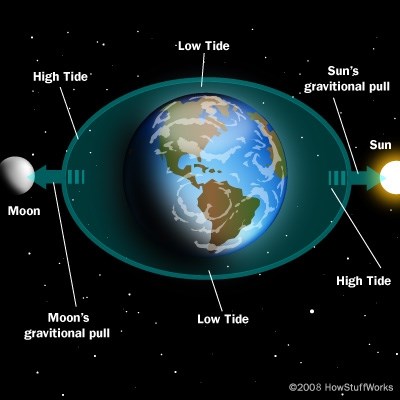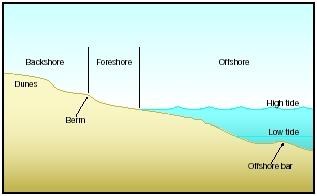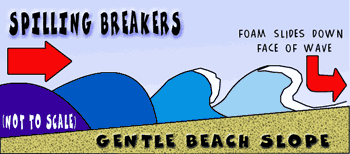This earthcache is located on the beach at Cocoa Beach Pier with permission. As of 10/8/13 parking is free after 4:00 pm and the earthcache can be done from the sand so you do not need to pay to go out on the pier. See the Cocoa Beach Pier website on the related webpage for current information. Cocoa Beach is famous for its beautiful beaches as well its good surfing conditions. The particular beach at Cocoa Beach Pier is an excellent place for beginners to learn how to catch a wave. Being that this is an earthcache, there is no physical container to find. To get your smiley for the cache, e-mail your answers for the questions below to the cache owner.
Beaches:
Beaches are defined as wave-deposited accumulations of sediment located along a shoreline. Beaches require a base to build on, which is usually made of bedrock. Beaches are mostly affected by tides. Tides are produced by the gravitational pull of the moon and sun acting on the rotating earth. This pull produces a very slight bulge in the ocean, which we know as tide. When the moon and sun line up with the earth, high tide occurs.

Beach Topography:
Beaches are commonly divided into two different zones: the foreshore and the back-shore. The foreshore zone is the area between the normal low tide (swash zone) mark and the normal high tide (swash zone) mark. The backshore zone is the area ordinarily affected by waves during a storm at high tide. Further from the back-shore zone may be cliffs, vegetation, or dunes which have been created by winds moving sand from the beach. Most of the time there is a mound of gravel that separates the foreshore and backshore with is called the berm. The berm runs parallel to the shoreline and is created by the action of waves and tides.

Beach Slope:
The 3 major factors that affect the slope of the beach are: grain size of beach particles, wave height, and wave period/length. Grain size is important as it controls the percolation of water into the sand. Coarse sand beaches which have a high degree of percolation have steeper slopes than fine sand beaches because they have less surface backwash and therefore less seaward movement of the grains.
Waves:
Waves are produced by winds in the ocean. As waves move toward the shore and into shallow water they come in contact with the ocean bottom. The ocean bottom causes friction which slows the wave down. Due to the fact that waves move in groups, they continue arriving behind each other and a bunch of waves are forced closer together. Since the waves are bunched together, they then grow in height and steepness. As the wave height increases, the crests become more peaked. As the steepness of the wave increases, the wave base becomes unstable. The forward speed of the crest moves faster than the speed of the wave, and the wave topples to the beach forming a breaker.
Breakers can be catagorized in three different ways: surging breakers, plunging breakers, and spilling breakers. Each of these types of breakers is determined by the slope of the shoreline. Surging Breakers occur on beaches where the slope is very steep.
Surging breaker waves do not actually break, but rather roll onto a steep beach. These kinds of breakers are known for their destructive nature.

Plunging Breakers occur on beaches where the slope is moderately steep. These types of waves normally curl over forming a tunnel until the wave breaks.

Spilling Breakers happen on beaches with gentle slopes. These waves break far from the shore, and the surf gently rolls over the front of the wave.

To get credit for the cache, please answer the questions below. When answering the questions do your best. It is more important that you learn a new concept about our earth and can apply your knowledge, rather than have a precise answer.
1- Describe the sand grain particles in this area of the beach.
2- What is the approximate distance in feet between each wave? How many seconds does it take before each new waves reaches the shore?
3- What is the approximate height of the waves in feet at the time of your visit? Would you categorize the beach waves as surging, plunging, or spilling breakers?
4- Would you categorize the beach slope as: steep, moderate, or gentle?
5- Why do you think Cocoa Beach is known as a good place for beginners to learn how to surf?
Thank you for visiting this earthcache. Please send your answers to the above questions to the cache owner. In your "found it" log feel free to write about your experience, but don't include the earthcache answers. Thanks and we hope you enjoy beautiful Cocoa Beach!

Sources:
http://www.sciencedirect.com/science/article/pii/S0012825211001784
https://www.uwgb.edu/dutchs/EarthSC102Notes/102Marine%20Geology.HTM
http://www.onr.navy.mil/focus/ocean/motion/waves2.htm
http://geology.uprm.edu/Morelock/beachsys.htm
http://www.ucmp.berkeley.edu/education/dynamic/session2/sess2_beach.html
http://geography.about.com/od/physicalgeography/a/waves.htm
http://www.nature.com/scitable/knowledge/library/coastal-processes-and-beaches-26276621
http://science.howstuffworks.com/environmental/earth/oceanography/tide-table1.htm
http://www.scienceclarified.com/landforms/Basins-to-Dunes/Coast-and-Shore.html